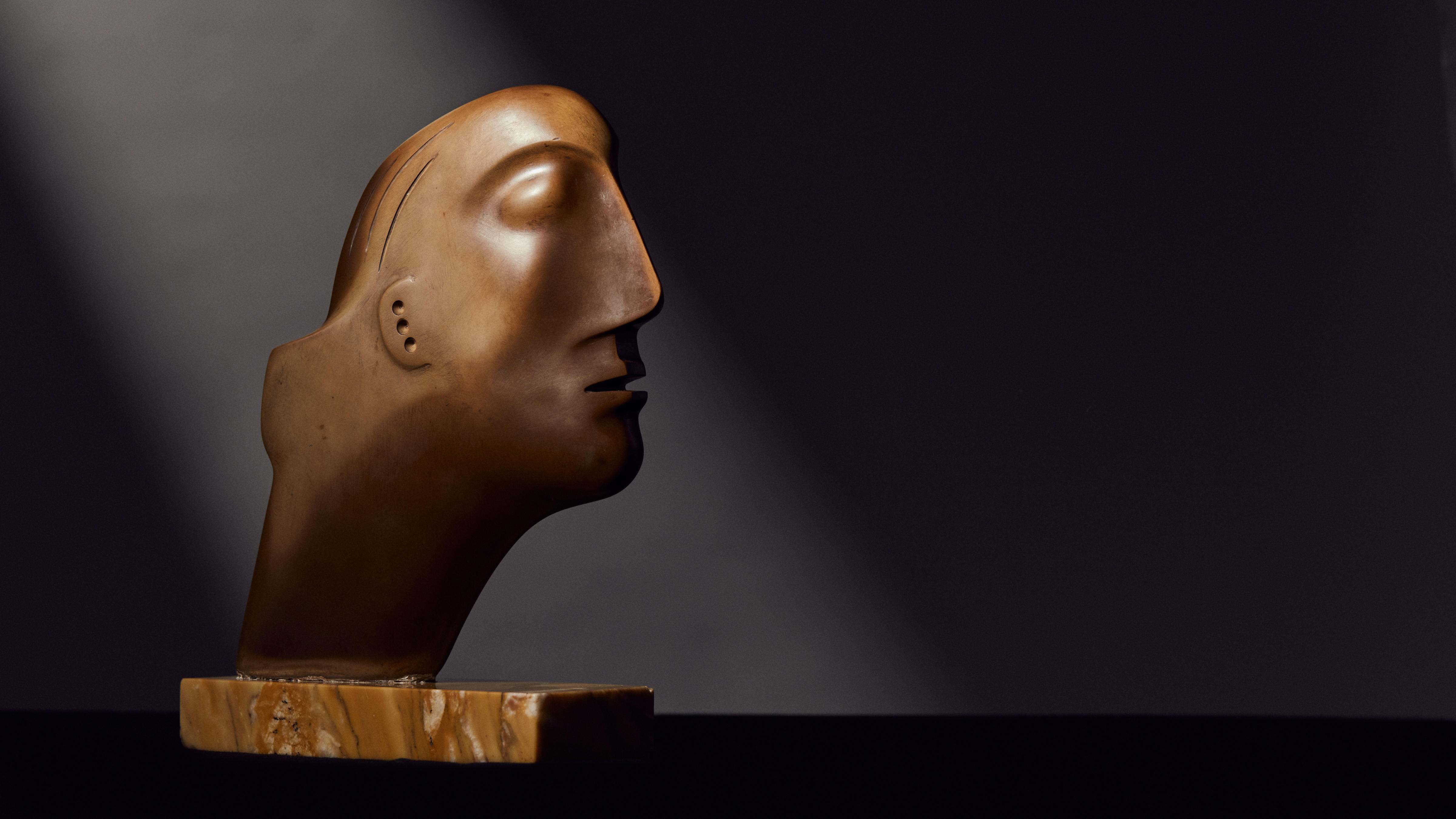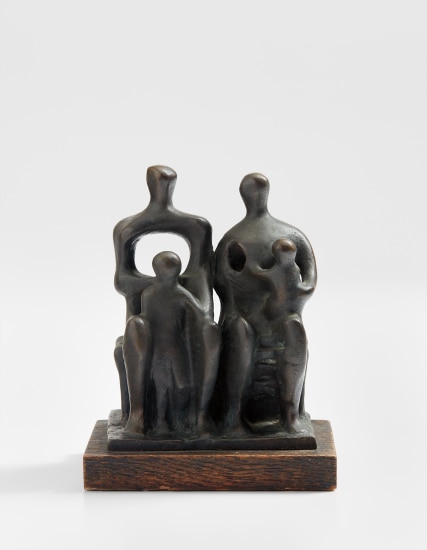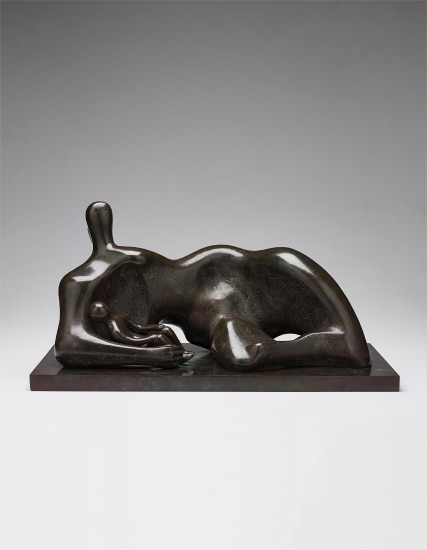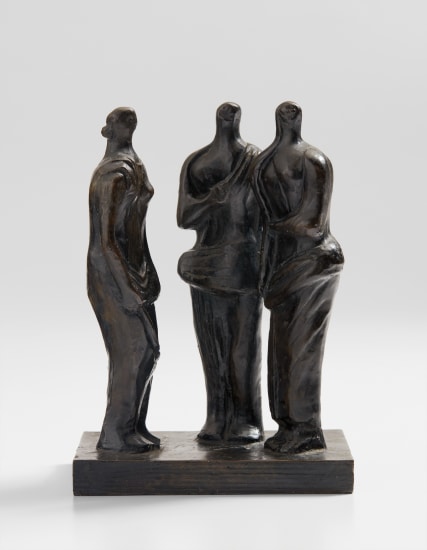Henry Moore O.M., C.H. (British, 1898-1986)Reclining Figure numbered '5/7' (on the top of the base); stamped with foundry mark 'C. VALSUANI CIRE PERDUE' (on the side of the base) bronze with a brown patina on a slate base 15.2 cm. (6 in.) long (excluding the base) Conceived in 1945FootnotesProvenance With Thomas Gibson Fine Art, prior to 1997, where acquired by Private Collection, U.K. Exhibited Stockholm, Samlaren Gallery, Henry Moore Skulptur, Teckningar, 1952 (another cast) Stockholm, Akademien, Henry Moore 1952, cat.no.121 (another cast) Literature David Sylvester Henry Moore Volume 1, Complete Sculpture 1921-1948, The Henry Moore Foundation in association with Lund Humphries, Much Hadham & London, 1988, p.15, cat.no.246 During his long and distinguished career, the 'reclining figure' along with the 'mother and child' were the two subjects that obsessed Henry Moore more than any other. Recent information from the Henry Moore Foundation indicates there are 270 examples of the reclining figure and 140 of the mother and child, perhaps confirming the former as the most significant; certainly the most fundamental. By 1968, Moore admitted this was the case: 'From the very beginning the reclining figure has been my main theme. The first one I made was around 1924, and probably more than half of my sculptures since then have been reclining figures' (John Hedgecoe Henry Moore London, Thomas Nelson, 1968, p.151). The origins of that first reclining figure (male and now destroyed) can be traced back to the Toltec-Mayan idol Chacmool. Impressed by a life-sized limestone carving from the eleventh or twelfth century found in Chichen Itza in Mexico, Moore came across a plaster cast of Chacmool on a visit to the Trocadero Museum in Paris in 1925. The curious reclining posture of the figure on its back, with knees drawn up and head twisted to the right fascinated Moore and it became 'undoubtedly the one sculpture which most influenced my early work' (Henry Moore Writings and Conversations, ed. Alan Wilkinson, London, Lund Humphries, 2002, p.98). The present work was conceived at the end of World War II in 1945 as a preparatory study for the 30 inch Hornton stone carving Reclining Figure (1947-49, LH 273, now in the collection of the Philadelphia Museum of Art). It was originally modelled in terracotta (whereabouts unknown) with an edition of seven cast in bronze. This was a particularly significant time as the end of conflict meant a renewed availability of metals and Moore was able to break free from the constraints of two dimensions and work more regularly in three. Reclining Figure is therefore one of the first sculptural examples of what the artist had absorbed through his graphic observations of the public sheltering from The Blitz in the London underground. The undulating profile of the sculpture draws on both the example of a body sheltering on the platform floor and the artist's early preoccupations with the naturalistic rendering of bones, rocks and mountainous landscape, as such she can be read as both abstract and human at the same time. Writing of the scaled up carving of the present form, John Russell comments 'After many Reclining Figures in which the central hole was the dominant compositional feature here is one in which, on the contrary, the central area is filled in. Such is the modelling of that area that two complementary movements are set up: one begins below the heart and swings up and away to the left, while the other begins at the bottom of the right thigh and swings up and away to the right. The relationship, here, between the thing seen and the thing imagined is one of the most moving in all Moore's work, in that the spreading and subtly modulated area between heart and knees is continuously alive in terms both of human anatomy and of the landscape-analogy, the sublimations of moorland and bluff, which Moore keeps going at the same time. This is not one of Moore's largest carvings – it is only thirty inches
Henry Moore O.M., C.H. (British, 1898-1986)Reclining Figure numbered '5/7' (on the top of the base); stamped with foundry mark 'C. VALSUANI CIRE PERDUE' (on the side of the base) bronze with a brown patina on a slate base 15.2 cm. (6 in.) long (excluding the base) Conceived in 1945FootnotesProvenance With Thomas Gibson Fine Art, prior to 1997, where acquired by Private Collection, U.K. Exhibited Stockholm, Samlaren Gallery, Henry Moore Skulptur, Teckningar, 1952 (another cast) Stockholm, Akademien, Henry Moore 1952, cat.no.121 (another cast) Literature David Sylvester Henry Moore Volume 1, Complete Sculpture 1921-1948, The Henry Moore Foundation in association with Lund Humphries, Much Hadham & London, 1988, p.15, cat.no.246 During his long and distinguished career, the 'reclining figure' along with the 'mother and child' were the two subjects that obsessed Henry Moore more than any other. Recent information from the Henry Moore Foundation indicates there are 270 examples of the reclining figure and 140 of the mother and child, perhaps confirming the former as the most significant; certainly the most fundamental. By 1968, Moore admitted this was the case: 'From the very beginning the reclining figure has been my main theme. The first one I made was around 1924, and probably more than half of my sculptures since then have been reclining figures' (John Hedgecoe Henry Moore London, Thomas Nelson, 1968, p.151). The origins of that first reclining figure (male and now destroyed) can be traced back to the Toltec-Mayan idol Chacmool. Impressed by a life-sized limestone carving from the eleventh or twelfth century found in Chichen Itza in Mexico, Moore came across a plaster cast of Chacmool on a visit to the Trocadero Museum in Paris in 1925. The curious reclining posture of the figure on its back, with knees drawn up and head twisted to the right fascinated Moore and it became 'undoubtedly the one sculpture which most influenced my early work' (Henry Moore Writings and Conversations, ed. Alan Wilkinson, London, Lund Humphries, 2002, p.98). The present work was conceived at the end of World War II in 1945 as a preparatory study for the 30 inch Hornton stone carving Reclining Figure (1947-49, LH 273, now in the collection of the Philadelphia Museum of Art). It was originally modelled in terracotta (whereabouts unknown) with an edition of seven cast in bronze. This was a particularly significant time as the end of conflict meant a renewed availability of metals and Moore was able to break free from the constraints of two dimensions and work more regularly in three. Reclining Figure is therefore one of the first sculptural examples of what the artist had absorbed through his graphic observations of the public sheltering from The Blitz in the London underground. The undulating profile of the sculpture draws on both the example of a body sheltering on the platform floor and the artist's early preoccupations with the naturalistic rendering of bones, rocks and mountainous landscape, as such she can be read as both abstract and human at the same time. Writing of the scaled up carving of the present form, John Russell comments 'After many Reclining Figures in which the central hole was the dominant compositional feature here is one in which, on the contrary, the central area is filled in. Such is the modelling of that area that two complementary movements are set up: one begins below the heart and swings up and away to the left, while the other begins at the bottom of the right thigh and swings up and away to the right. The relationship, here, between the thing seen and the thing imagined is one of the most moving in all Moore's work, in that the spreading and subtly modulated area between heart and knees is continuously alive in terms both of human anatomy and of the landscape-analogy, the sublimations of moorland and bluff, which Moore keeps going at the same time. This is not one of Moore's largest carvings – it is only thirty inches
.jpg)


.jpg)


.jpg)
.jpg)







Testen Sie LotSearch und seine Premium-Features 7 Tage - ohne Kosten!
Lassen Sie sich automatisch über neue Objekte in kommenden Auktionen benachrichtigen.
Suchauftrag anlegen